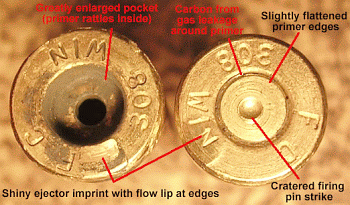Mike1,
If you read the history of the M16, you find the military did two things about slamfires after the Marine Corps had some while single-loading the rifle during testing: They lightened the firing pin and reduced primer sensitivity. This is because it turned out, in review questioning, that Eugene Stoner didn't know about or understand primer sensitivity specifications, so this was a patch. Today we shoot with the lightened firing pins, but I've seen no information, other than some individual's personal opinions, to suggest the lightened firing pin means the primers can go back to being more sensitive. Certainly the military didn't do that. Indeed, read this post by board member Slamfire which describes the slamfire he had in an AR with WSR primers and others he's been present for.
As to the brass, you are right. It is only .308 Winchester brass that is lighter and has more capacity on average than 7.62 NATO brass does. That's the end of a consistent pattern between commercial and military brass. The Lake City .30-06 is a little heavier than some commercial brands and a little lighter than some others. Lake City 5.56 NATO tends to be on the light end of the commercial weight range for .223 Remington. But what happened with .308/7.62 brass seems to stick in everyone's memory and winds up being treated as a universal truth.
There seems to be a lot of overgeneralizing about shooting technology, but I don't find that unique. I find people do it with refrigeration and other technical areas I've been involved in, too. I think it is just more comfortable and less overwhelming to believe everything is simpler than it really is. And that's OK for applied work, often. It just becomes not OK when the generalizations are applied to start breaking the rules.
If you read the history of the M16, you find the military did two things about slamfires after the Marine Corps had some while single-loading the rifle during testing: They lightened the firing pin and reduced primer sensitivity. This is because it turned out, in review questioning, that Eugene Stoner didn't know about or understand primer sensitivity specifications, so this was a patch. Today we shoot with the lightened firing pins, but I've seen no information, other than some individual's personal opinions, to suggest the lightened firing pin means the primers can go back to being more sensitive. Certainly the military didn't do that. Indeed, read this post by board member Slamfire which describes the slamfire he had in an AR with WSR primers and others he's been present for.
As to the brass, you are right. It is only .308 Winchester brass that is lighter and has more capacity on average than 7.62 NATO brass does. That's the end of a consistent pattern between commercial and military brass. The Lake City .30-06 is a little heavier than some commercial brands and a little lighter than some others. Lake City 5.56 NATO tends to be on the light end of the commercial weight range for .223 Remington. But what happened with .308/7.62 brass seems to stick in everyone's memory and winds up being treated as a universal truth.
There seems to be a lot of overgeneralizing about shooting technology, but I don't find that unique. I find people do it with refrigeration and other technical areas I've been involved in, too. I think it is just more comfortable and less overwhelming to believe everything is simpler than it really is. And that's OK for applied work, often. It just becomes not OK when the generalizations are applied to start breaking the rules.

